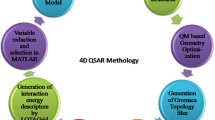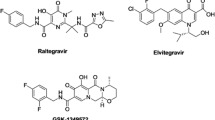Abstract
In this study, QSAR modeling was performed for predicting the IC50 value for a set of HIV-1 integrase inhibitors using multiple regression and partial least square method obtaining an optimized model for each method. These models were used to predict a set of test compounds obtained by performing a chemical similarity search of the training set from the NCBI PubChem database subjected to the Lipinski rule of five filters. The predicted IC50 value for the test set compounds was further analyzed for molecular docking simulation against HIV-1 integrase revealing that the test set compounds have a more binding affinity than the training set compounds and the market approved drug raltegravir. The stability of the docked compounds (protein–ligand complexes) was further validated by performing molecular dynamics simulations for 20 ns using Gromacs 5.0, and the RMSD backbone was analyzed. Last, the ADME–toxicity analysis was carried out for the top docking hit compounds and the market approved drug raltegravir revealing that the docked compounds have enhanced pharmacological parameters than raltegravir.








Similar content being viewed by others
References
Advanced Chemistry Development, Inc: ACD/I-Lab, Version 2.0 (1994). Toronto, ON, Canada
Alavijeh MS, Chishty M, Qaiser MZ, Palmer AM (2005) Drug metabolism and pharmacokinetics, the blood–brain barrier, and central nervous system drug discovery. NeuroRx. 2:554–571
Anthony NJ (2004) HV-1 integrase: a target for new AIDS chemotherapeutics. Curr Top Med Chem 4:979–990
Bolton E, Wang Y, Thiessen PA, Bryant SH (2008) PubChem: integrated platform of small molecules and biological activities. Chapter 12. In: Annual Reports in Computational Chemistry, vol 4. American Chemical Society, Washington
ChemOffice (2010) CambridgeSoft Corporation, 875 Massachusetts Ave, Cambridge, MA 02139, USA
Douek DC, Roederer M, Koup RA (2009) Emerging concepts in the immunopathogenesis of AIDS. Ann Rev Med 60:471–484
Fikkert V, Van Maele B, Vercammen J, Hantson A, Van Remoortel B, Michiels M, Gurnari C, Pannecouque C, De Maeyer M, Engelborghs Y, De Clercq E, Debyser Z, Witvrouw M (2003) Development of resistance against diketo derivatives of human immunodeficiency virus type 1 by progressive accumulation of integrase mutations. Science 287:646–650
Fisher RA (1922) The goodness of fit of regression formulae and the distribution of regression coefficients. J R Stat Soc. 85:597–612
Ghasemi JB, Shiri F, Pirhadi S, Heidari Z (2015) Discovery of new potential antimalarial compounds using virtual screening of ZINC database. Comb Chem High Throughput Screen. 18:227–234
Grobler JA, Stillmock K, Hu B, Witmer M, Felock P, Espeseth AS, Wolfe A, Egbertson M, Bourgeois M, Melamed J, Wai JS, Young S, Vacca J, Hazuda DJ (2002) Diketo acid inhibitor mechanism and HIV-1 integrase: implications for metal binding in the active site of phosphotransferase enzymes. Proc Natl Acad Sci USA 99:6661–6666
Ildiko FE, Friedman JH (1993) A statistical view of some chemometrics regression tools. Technometrics 35:109–148
Imamichi T (2004) Action of anti-HIV drugs and resistance: reverse transcriptase inhibitors and protease inhibitors. Curr Pharm Des 10:4039–4053
Johnson AA, Marchand C, Pommier Y (2004) HIV-1 integrase inhibitors: a decade of research and two drugs in clinical trial. Curr Top Med Chem 4:1059–1077
Kessl JJ, Jena N, Koh Y, Taskent-Sezgin H, Slaughter A, Feng L, de Silva S, Wu L, Le Grice SF, Engelman A, Fuchs JR, Kvaratskhelia M (2012) Multimode, cooperative mechanism of action of allosteric HIV-1 integrase inhibitors. J Biol Chem 287:16801–16811
Lipinski CA (2000) Drug-like properties and the causes of poor solubility and poor permeability. J Pharmacol Toxicol Methods 44:235–249
Malet I, Delelis O, Valantin MA, Montes B, Soulie C, Wirden M, Tchertanov L, Peytavin G, Reynes J, Mouscadet JF, Katlama C, Calvez V, Marcelin AG (2008) Mutations associated with failure of raltegravir treatment affect integrase sensitivity to the inhibitor in vitro. Antimicrob Agents Chemother 52:1351–1358
MDL QSAR (2006) MDL Information Systems Inc, USA
Molegro APS (2011) MVD 5.0 Molegro Virtual Docker. DK-8000 Aarhus C, Denmark
Murray JM, Emery S, Kelleher AD, Law M, Chen J, Hazuda DJ, Nguyen BY, Teppler H, Cooper DA (2007) Antiretroviral therapy with the integrase inhibitor raltegravir alters decay kinetics of HIV, significantly reducing the second phase. Aids 21:2315–2321
Thomsen R, Christensen MH (2006) MolDock: a new technique for high-accuracy molecular docking. J Med Chem 49:3315–3321
Ulrich B, Norman LA (1982) ACS Monograph 177. American Chemical Society, Washington
Van Der Spoel D, Lindahl E, Hess B, Groenhof G, Mark AE, Berendsen HJ (2005) GROMACS: fast, flexible, and free. J Comput Chem 26:1701–1718
Wang Y, Xiao J, Suzek TO, Zhang J, Wang J, Zhou Z, Han L, Karapetyan K, Dracheva S, Shoemaker BA, Bolton E, Gindulyte A, Bryant SH (2012) PubChem’s bioassay database. Nucleic Acids Res 40:D400–D4012
Weiss RA (1993) How does HIV cause AIDS? Science 260:1273–1279
Acknowledgements
The authors acknowledged the Department of Biotechnology, Ministry of Science and Technology, Government of India, New Delhi for necessary support.
Author information
Authors and Affiliations
Corresponding author
Ethics declarations
Conflict of interest
The authors declare that no conflicts of interest exist.
Electronic supplementary material
Below is the link to the electronic supplementary material.
Rights and permissions
About this article
Cite this article
Singh, S.P., Deb, C.R., Kakati, L.N. et al. QSAR-based drug designing studies on HIV-1 integrase inhibitors. Netw Model Anal Health Inform Bioinforma 5, 33 (2016). https://doi.org/10.1007/s13721-016-0141-6
Received:
Accepted:
Published:
DOI: https://doi.org/10.1007/s13721-016-0141-6




